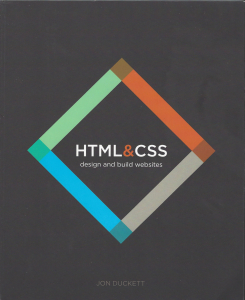Duckett Designs Websites; Introduces CSS
 Jon Duckett. 2011. HTML & CSS: Design and Build Websites. Indianapolis: John Wiley and Sons.
Jon Duckett. 2011. HTML & CSS: Design and Build Websites. Indianapolis: John Wiley and Sons.
Review by Stephen W. Hiemstra
Over the years, I have purchased an office full of books about computers, programming languages, operating systems, and social media. Most of these books have nothing to do with another passion of mine, which is writing and publishing. Jon Duckett’s book, HTML & CSS, is decidedly different, falling squarely in the middle of these two fields.
For the uninitiated, HTML is short for hypertext markup language and CSS is short for cascading style sheets. These two scripting languages come together when the task at hand is designing and programming out high-quality, well-designed websites. Both programming languages may be somewhat invisible—under-the-hood—if you are like me, and create webpages in Word and simply save the result as an *.htm file.
For the observant, this design focus is obvious from the high quality paper-stock employed in printing Duckett’s text. The paper used in color printing is often heavier than regular printed pages, in part, so the colors will not bleed through one side of the page to the other, a problem most obvious in newspaper print. High quality paper-stock also gives a book a certain nonverbal gravitas that is impossible to reproduce with other paper. If you are clueless about all that, the cover sports a stunning design, which reinforces the design focus—this book is definitely coffee-table ready, setting it apart from other computer books.
The design focus of Duckette’s book comes as a surprise because hypertext is best known for being somewhat plain, allowing relatively few variations on basic formats. The old image of hypertext is kind of like Henry Ford’s admonition, “you can have any color you want, provided you want black”. Hypertext has historically not offered text options typically found in other print media. I was pleasantly surprised to read explanations on how to download alternative typefaces more typically found in topography books. Now, for example, things like first letter variations (something like a drop letter) can be rendered directly (289). With the introduction of CSS, hypertext is starting to allow a great deal more flexibility.
Duckette writes to communicate designing his book with this in mind. He focuses on the tags most frequently used in programming, structures the book around HTML, CSS, and practical examples, and discusses features following the way that people access the internet: browsers, web services, devices, and screen-readers (5-7). The book is organized into 19 chapters, preceded by an introduction and followed by an index:
Introduction
1. Structure.
2. Text.
3. Lists.
4. Links.
5. Images.
6. Tables.
7. Forms.
8. Extra Markup.
9. Flash, Video, and Audio.
10. Introducing CSS.
11. Color.
12. Text.
13. Boxes.
14. Lists, Tables, and Forms.
15. Layout.
16. Images.
17. HTMLS Layout.
18. Process and Design.
19. Practical Information.
Index.
The codes examples used in the book can be downloaded at: http://www.HTMLandCSSBook.com/code.
Jon Duckett’s book, HTML & CSS, provides an accessible introduction to HTML and CSS for both beginning website designers and those looking for a reference guide. The examples are easy to follow and he directs the reader to helpful resources online.





